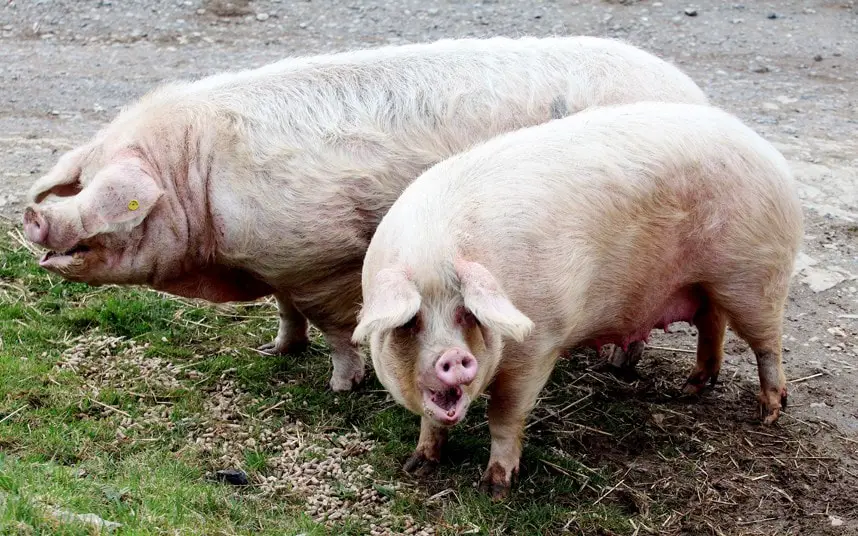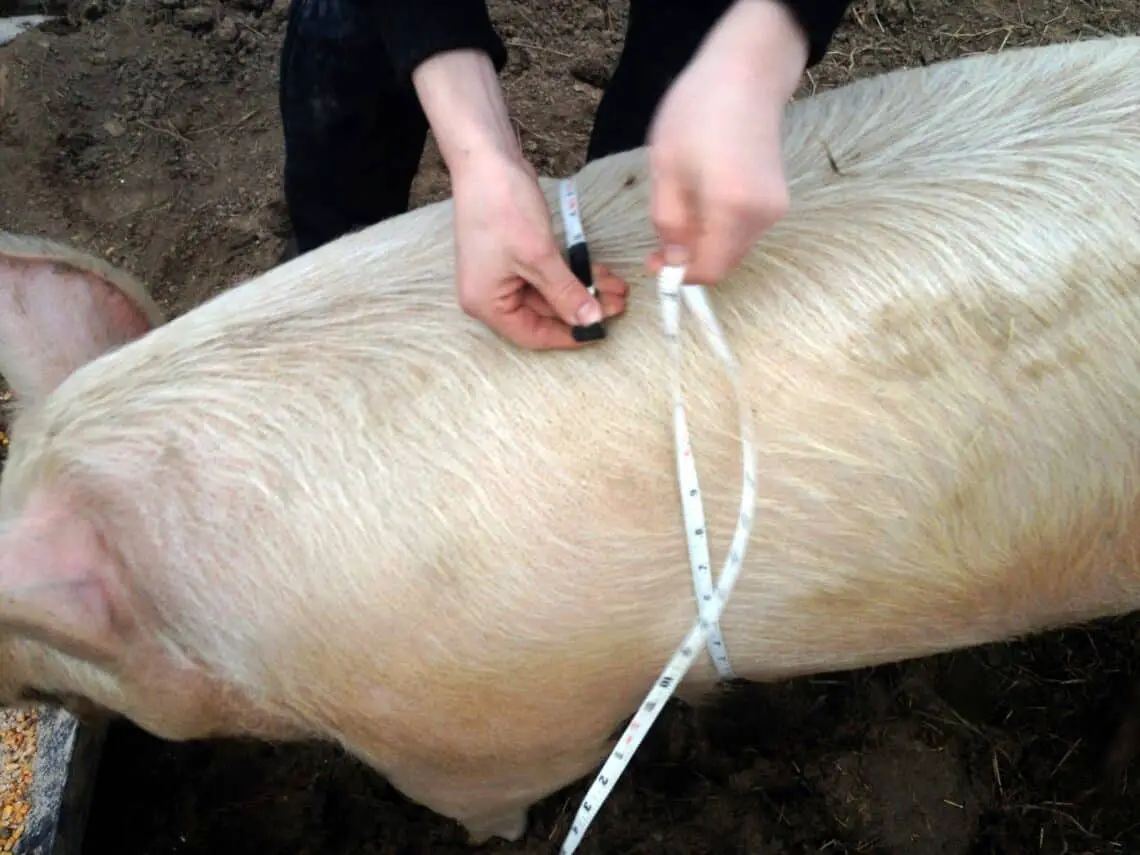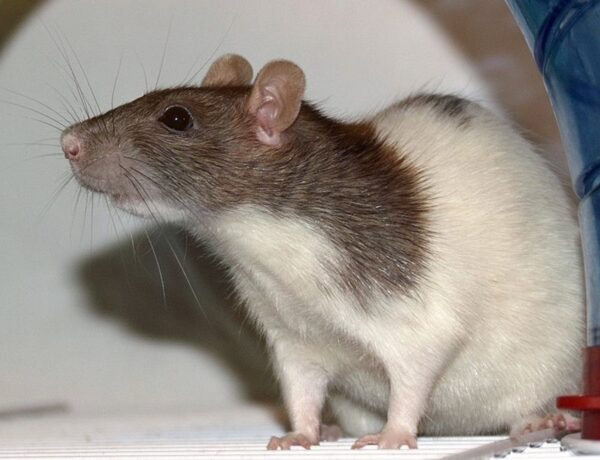Introduction
Pigs are remarkable creatures that have been domesticated for thousands of years, providing humanity with a source of sustenance and economic value. One of the most common questions associated with these animals is, “How much does a pig weigh?” The answer to this question varies widely depending on several factors, including the pig’s age, breed, and purpose. In this discussion, we will delve into the diverse world of pig weights, exploring the factors that influence their size and why understanding their weight is essential in various agricultural and culinary contexts.
The weight of a pig is heavily influenced by its age. Pigs go through distinct growth stages, with the most rapid growth occurring during the early months of their lives. Newborn piglets typically weigh around 2 to 3 pounds (0.9 to 1.4 kilograms) at birth, and their weight increases exponentially as they consume milk from their mother and transition to solid food. By the time a pig reaches its market weight, it can weigh anywhere from 200 to 700 pounds (90 to 318 kilograms) or even more, depending on the breed and specific breeding practices.
The breed of the pig plays a significant role in determining its weight. Different pig breeds have been selectively bred for various purposes, such as meat production or lard, resulting in varying sizes and weights. For instance, heritage breeds like the Gloucestershire Old Spot tend to be larger and heavier, whereas commercial breeds like the Yorkshire or Hampshire are often raised for their meat and thus reach market weight at a younger age and lower weight.

How much does a fully grown pig weigh?
Pigs are considered full grown at six months and can weigh between 300 and 700 pounds!
The breed of the pig plays a crucial role in determining its weight. There are various pig breeds, and each has its own growth rate and potential size. For instance, miniature or “teacup” pig breeds tend to stay relatively small, usually weighing around 100 pounds (45 kilograms) when fully grown. In contrast, larger breeds like the Hampshire or Yorkshire can reach weights of 600 to 700 pounds (272 to 318 kilograms) or even more. Breed selection is a key consideration for farmers and breeders aiming to produce pigs of a specific size for various purposes, including meat production.
Diet is another vital factor in determining a pig’s final weight. Pigs are omnivores and have a voracious appetite, which makes it relatively easy for them to gain weight quickly if fed appropriately. Farmers and breeders often provide pigs with specially formulated feeds that are high in calories and nutrients to promote rapid growth. Proper nutrition management, along with access to clean water, is essential for achieving the desired weight in a pig.
Genetics also play a significant role in a pig’s weight potential. Some pigs may have genetics that predispose them to grow larger and gain weight more efficiently than others. Selective breeding programs have been developed to enhance these genetic traits, leading to the creation of pig lines specifically bred for meat production. Through generations of selective breeding, pig farmers have been able to produce animals that reach their target weight faster and with less feed.
What is the weight of a pig in KG?
Male pigs average weight is 300-350 kgs and female pigs average weight is 250- 300 kgs. Average litter size 10-12 piglets.
Age and Development:
The weight of a pig in kilograms is closely linked to its age and stage of development. Pigs are born weighing around 1 to 1.5 kilograms (2.2 to 3.3 pounds). In the early stages of life, their weight gain is rapid. By the time they are weaned at around 6 to 8 weeks, piglets can typically weigh between 5 to 15 kilograms (11 to 33 pounds), depending on their diet and genetics. After weaning, their growth rate slows down, but they continue to gain weight steadily.
As pigs enter the growing phase, which spans from 3 to 6 months of age, their weight can vary significantly depending on the breed and the quality of their nutrition. In this phase, pigs can weigh anywhere from 30 to 100 kilograms (66 to 220 pounds). Breed plays a crucial role, as some breeds are naturally larger and grow faster than others. For instance, heritage breeds tend to grow more slowly and reach lower weights compared to commercial breeds that have been selectively bred for rapid growth.
The finishing phase, which occurs from 6 months to market weight, is when pigs experience their most substantial weight gain. At this stage, commercial pigs can reach market weight, which typically ranges from 100 to 130 kilograms (220 to 286 pounds) for market hogs raised for pork production. However, some breeds and specialized production systems can yield pigs weighing as much as 150 kilograms (330 pounds) or more.
Breed Variability:
Breed is a significant factor when considering the weight of a pig in kilograms. Different pig breeds have distinct growth rates and weight potentials. For example, Yorkshire pigs are known for their rapid growth and can achieve market weight in a relatively short time, whereas Tamworth pigs, a heritage breed, grow more slowly and have a lower average market weight.
Nutrition and Management:
Proper nutrition and management practices are critical factors in determining a pig’s weight. Pigs that receive a balanced and nutrient-dense diet from a young age are more likely to reach their full growth potential. Inadequate nutrition can result in stunted growth and lower final weights. Conversely, overfeeding can lead to excessive fat deposition and health issues.
Moreover, the environment in which pigs are raised also plays a role in their weight. Pigs that are raised in clean and comfortable conditions with access to proper healthcare tend to grow better and achieve higher weights. Stressors such as overcrowding, poor ventilation, or disease can hinder a pig’s growth and weight gain.
How old is a 100kg pig?
The average meat pig weighing 50 lbs. (22 kg) being 7 weeks old will have a weight of 230 lbs. (100 kg) being 20 weeks old. The market weight differs from breed to breed, but most pigs are slaughtered at 250 lbs.
Weight as an Indicator of Age:
One common method of estimating a pig’s age is by considering its weight. Pigs, like humans, experience a rapid growth spurt during their early stages of life. A piglet is typically born weighing around 1 to 3 pounds (0.45 to 1.36 kilograms), and during the first few weeks of life, they can gain weight at an astonishing rate. On average, a healthy piglet can gain about 0.45 to 0.68 kilograms (1 to 1.5 pounds) per day during this period.
As they continue to grow, their weight gain gradually slows down. By the time a pig reaches 100kg (220 pounds), it is generally considered to be a sub-adult or young adult, depending on the breed. This stage of development typically occurs around 6 to 9 months of age for commercial pig breeds raised for meat production. However, the exact age at which a pig reaches 100kg can vary based on factors such as genetics, diet, and overall health.
Monitoring Growth for Health and Productivity:
Monitoring the growth of pigs is crucial for both their health and productivity. Farmers and veterinarians use growth charts and weight milestones to ensure that pigs are developing as expected. Early growth is particularly critical, as it can indicate the pig’s overall health and the effectiveness of its nutrition. If a pig is not gaining weight at the expected rate, it may be a sign of underlying health issues or nutritional deficiencies that need to be addressed promptly.
Additionally, tracking growth helps farmers make informed decisions about the timing of various management practices, such as weaning, vaccination, and marketing for meat production. Properly managing the growth of pigs ensures that they reach market weight efficiently, maximizing the economic return for the farmer.
Factors Influencing Growth Rate:
Several factors can influence the rate at which a pig reaches 100kg. Genetics play a significant role, as different pig breeds have distinct growth rates and mature at different ages. For example, heritage or traditional breeds may take longer to reach 100kg compared to modern commercial breeds bred specifically for rapid growth.
Nutrition is another critical factor. Pigs that receive a well-balanced diet with the right mix of protein, carbohydrates, vitamins, and minerals are more likely to grow quickly and reach 100kg at a younger age. On the other hand, inadequate or imbalanced nutrition can stunt growth and delay maturity.
How much of a pig is waste?
On average about 57% of a hog make it from the pen to the pan. A 250 lb. hog will yield approximately 144 lbs of retail cuts. Around 28% of a hog’s live weight is inedible product re- moved during the slaughter and dressing procedure bringing our 250 lb.
When we think of pigs, the first thing that comes to mind is the succulent meat that graces our tables. Pork, in its various forms, is the primary product of pig farming and is enjoyed by people worldwide. Pork ribs, pork belly, sausages, and many other cuts make up the culinary treasures of this animal. While some may consider portions of the pig as waste, such as the head, trotters, and organs, these parts are used in many culinary traditions around the world. For example, dishes like headcheese, pig’s feet stew, and liver pâté showcase the utilization of these often overlooked parts, reducing waste in the process.
Moreover, the pig industry has evolved to minimize waste through innovations and efficient practices. Modern pig farming techniques aim to make the most out of each animal. From using pig manure as fertilizer for crops to feeding pigs with food byproducts like food waste and agricultural residues, the industry strives to reduce its environmental footprint and minimize waste generation.
Beyond the realm of food, pigs contribute to a wide range of non-food products. One of the most significant byproducts is collagen, which can be extracted from pig skin and bones. Collagen finds its way into a plethora of products, including cosmetics, pharmaceuticals, and even surgical sutures. This valuable substance has numerous applications in medicine and industry, demonstrating that almost no part of the pig goes to waste in the modern world.
How much does a 5 month old pig weigh in kg?
A piglet weighs around 1.5 kg at birth. Young male piglets already weigh 20 kg at the age of ten weeks. Five or six months later, they weigh 100 kg and are ready to be slaughtered at an abattoir or by a traditional butcher.
The weight of a 5-month-old pig can vary significantly depending on various factors such as breed, genetics, diet, and overall health. However, on average, a 5-month-old pig typically weighs between 45 to 90 kilograms (99 to 198 pounds).
The weight of a piglet at birth is relatively small, usually around 1 to 1.5 kilograms (2.2 to 3.3 pounds), and they gain weight rapidly during the first few months of their lives. This rapid growth is one of the reasons why pigs are often raised for meat production, as they can reach a marketable weight in a relatively short period of time.
The breed of the pig plays a significant role in determining its final weight. Some pig breeds are known for their rapid growth and ability to reach higher weights in a shorter amount of time, while others may have slower growth rates. Popular pig breeds for meat production include Yorkshire, Duroc, Hampshire, and Berkshire, among others.
Genetics also play a crucial role in a pig’s growth rate and final weight. Pigs from a lineage of larger, heavier individuals are more likely to reach higher weights by the age of 5 months compared to pigs with genetics that favor smaller sizes. Selective breeding is often used to enhance desirable traits, including growth rate and weight gain, in commercial pig farming.
How big is the heaviest pig?
The Biggest Domestic Pig Weighed Over a Ton
Big Bill was the largest pig ever on record. He was a Poland China breed who stood 5 feet tall and weighed 2,552 pounds. Big Bill has held the record since 1933!
The weight of the heaviest pig in recorded history is a topic that has captured the curiosity of animal enthusiasts and researchers alike. Pigs, known for their voracious appetite and ability to pack on pounds, have occasionally reached astonishing sizes, leaving people in awe of the sheer magnitude of these porcine behemoths. To delve into the world of the heaviest pig ever recorded, we must journey through history, explore the factors contributing to their size, and discuss the implications of such colossal creatures.
The title of the heaviest pig in recorded history belongs to a hog named “Big Bill,” a colossal swine that resided in Jackson, Tennessee, during the early 1930s. Big Bill’s enormous girth astounded the world when he tipped the scales at a staggering 2,552 pounds (1,157 kilograms) at the time of his weighing in 1933. This incredible weight was more than double the size of an average adult male polar bear and roughly equivalent to the weight of a small car. Big Bill’s record-setting bulk earned him a place in the annals of animal history, and his story continues to captivate audiences today.
Several factors contributed to Big Bill’s unprecedented size. Genetics played a significant role, as he descended from a lineage of large swine with a propensity for rapid growth. Diet and nutrition also played a crucial role in his extraordinary growth. Big Bill was fed a steady diet of high-calorie grains, vegetables, and, of course, copious amounts of food scraps. This calorie-rich diet, combined with his genetic predisposition for growth, allowed him to pack on the pounds at an astonishing rate.
How many people will a 60kg pig feed?
A typical pig is around 60kg in weight and will comfortably feed 80 – 100 guests. The pig is cooked before hand at our shop for 6 hours in our hog roast oven and then it is delivered to your location an hour and a half before the event starts so we can prepare for service.
Firstly, it’s essential to understand that a 60kg pig is considered a relatively large pig and can provide a substantial amount of meat. The yield of meat from a pig can vary, but on average, you can expect to get about 70-80% of the pig’s live weight in meat. So, from a 60kg pig, you can typically obtain around 42kg to 48kg of meat.
The portion size plays a significant role in determining how many people a 60kg pig can feed. In many cultures, a typical serving of pork is around 3-4 ounces (85-115 grams) per person. This includes some variation for different cuts and preparations. If we use an average portion size of 3.5 ounces (100 grams) per person, the meat from a 60kg pig could potentially serve approximately 420 to 480 people.
However, it’s important to consider that a pig consists of various cuts of meat, some of which are more desirable and tender than others. For example, the pork loin and pork tenderloin are typically considered premium cuts and are highly sought after. These cuts make for smaller portions compared to the larger, tougher cuts like pork shoulder or pork belly, which may be used in dishes that can serve more people.
How much should a 2 month old pig eat?
5 Weeks to 3 Months
After weaning, each piglet should receive 3/4 cup of food per day, using at least a 16% protein grower ration. Your judgment comes into play here, but I firmly believe that 3/4 cup per day per pig is the minimum for this age range.
Feeding a 2-month-old pig is a crucial aspect of pig farming and animal husbandry. At this age, piglets are still in their early stages of growth and development, and their nutritional needs are essential to ensure they grow into healthy and robust pigs. The amount a 2-month-old pig should eat depends on various factors, including their breed, weight, and individual appetite. However, there are some general guidelines that can help farmers determine the appropriate feeding regimen for their piglets.
It’s important to recognize that there are different pig breeds, and each may have slightly different dietary requirements. However, on average, a 2-month-old piglet should be consuming about 1.5 to 2 pounds of pig starter feed per day. This feed is specially formulated to meet the nutritional needs of growing piglets, providing essential proteins, carbohydrates, vitamins, and minerals. It’s crucial to follow the feeding recommendations provided by the feed manufacturer, as these formulations are based on extensive research to support healthy growth.
The weight of the piglet also plays a significant role in determining its daily food intake. On average, a 2-month-old piglet may weigh between 15 to 30 pounds, but this can vary widely depending on the breed. To ensure proper growth, it’s recommended to feed piglets 3% to 4% of their body wei
ght in feed each day. For instance, if a piglet weighs 20 pounds, it should consume approximately 0.6 to 0.8 pounds of pig starter feed daily. Monitoring the piglet’s weight and adjusting the feed amount accordingly is essential to prevent underfeeding or overfeeding, which can lead to health issues.

Conclusion
The weight of a pig can vary significantly depending on several factors, such as its breed, age, and overall health. On average, a mature pig can weigh anywhere from 250 to 700 pounds or more. This wide range is due to the diversity of pig breeds, with some smaller heritage breeds weighing less, while commercial breeds bred for meat production tend to be much heavier.
The weight of a pig is an essential consideration for farmers and those in the pork industry, as it directly impacts the quantity of meat that can be harvested for consumption. Accurate weight estimation is crucial for proper feeding, healthcare, and market readiness.
Overall, understanding the weight of a pig is not only important for economic reasons but also for ensuring the welfare of the animals and the quality of the meat produced. It serves as a fundamental factor in the management and success of pig farming operations worldwide.





No Comments